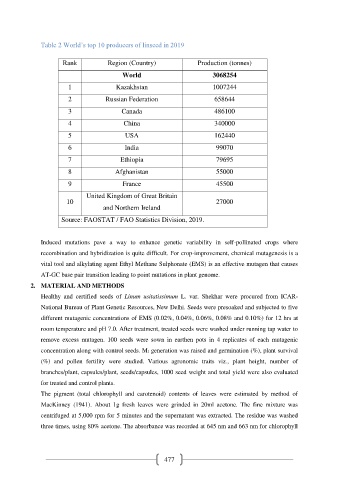Page 487 - e-Book
P. 487
Table 2 World’s top 10 producers of linseed in 2019
Rank Region (Country) Production (tonnes)
World 3068254
1 Kazakhstan 1007244
2 Russian Federation 658644
3 Canada 486100
4 China 340000
5 USA 162440
6 India 99070
7 Ethiopia 79695
8 Afghanistan 55000
9 France 45500
United Kingdom of Great Britain
10 27000
and Northern Ireland
Source: FAOSTAT / FAO Statistics Division, 2019.
Induced mutations pave a way to enhance genetic variability in self-pollinated crops where
recombination and hybridization is quite difficult. For crop-improvement, chemical mutagenesis is a
vital tool and alkylating agent Ethyl Methane Sulphonate (EMS) is an effective mutagen that causes
AT-GC base pair transition leading to point mutations in plant genome.
2. MATERIAL AND METHODS
Healthy and certified seeds of Linum usitatissimum L. var. Shekhar were procured from ICAR-
National Bureau of Plant Genetic Resources, New Delhi. Seeds were presoaked and subjected to five
different mutagenic concentrations of EMS (0.02%, 0.04%, 0.06%, 0.08% and 0.10%) for 12 hrs at
room temperature and pH 7.0. After treatment, treated seeds were washed under running tap water to
remove excess mutagen. 100 seeds were sown in earthen pots in 4 replicates of each mutagenic
concentration along with control seeds. M1 generation was raised and germination (%), plant survival
(%) and pollen fertility were studied. Various agronomic traits viz., plant height, number of
branches/plant, capsules/plant, seeds/capsules, 1000 seed weight and total yield were also evaluated
for treated and control plants.
The pigment (total chlorophyll and carotenoid) contents of leaves were estimated by method of
MacKinney (1941). About 1g fresh leaves were grinded in 20ml acetone. The fine mixture was
centrifuged at 5,000 rpm for 5 minutes and the supernatant was extracted. The residue was washed
three times, using 80% acetone. The absorbance was recorded at 645 nm and 663 nm for chlorophyll
477

